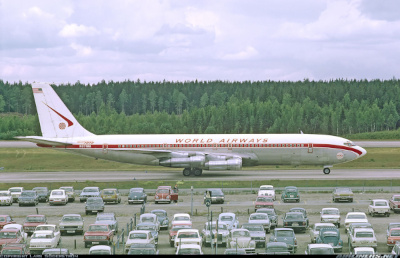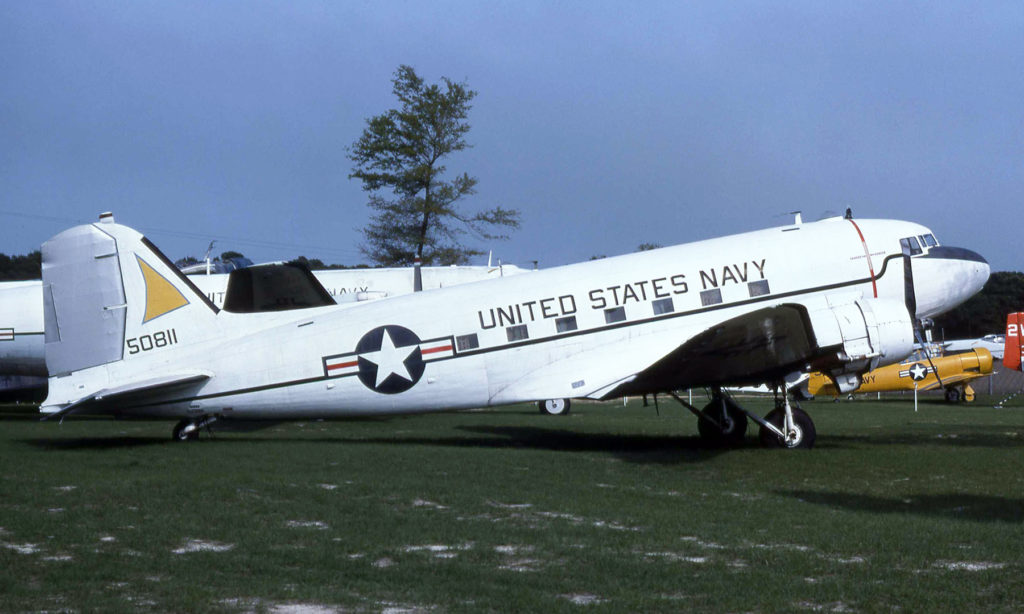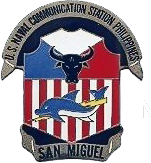Heading Overseas
I arrived at Travis in the early afternoon on 25 July but the flight wouldn’t leave until about 11:30 pm. It was a long and boring wait. The war in Vietnam was raging hot and heavy and the terminal was packed with young soldiers in full combat gear. There was little room to sit and the floor was covered with duffel bags and weapons. Eventually a few other CT’s I knew from “A” school showed up so I didn’t feel totally isolated anymore.

The flight was a World Airways military charter aboard a “stretch” 707 which was a Boeing 707 with an extra eight feet of length for more seats in the cabin. The Seats were close together and every one was filled. It took forever to load. Lots of soldiers were carrying on gear that they couldn’t stow and trying to get into seats that were too small. About half the flight was filled with dependents, wives and children and the kid right behind me, in a middle seat, was a brat that kept kicking the back of my chair the entire flight. Finally, after what seemed like an eternity, we taxied to the end of the runway and started our takeoff. The plane was overloaded; the engines were wound up about as tight as the pilot could get them. He released the brakes and we began to lumber down the runway; clump-clump… clump-clump… clump-clump a litter faster and closer together with each second that ticked by. Eventually we were rattling and shacking down the runway at a high rate of speed. An Air Force pilot had the window seat next to me. I peaked out as best I could and saw the blue runway lights flying past us in a dark, drizzly night. “There goes the first abort marker” he announced. The airplane was beginning to bounce over the runway. “There goes the second abort marker”. By now I was sure the aircraft was going to shake to pieces. “There goes the third abort marker” and then the plane lifted off the runway with a huge BOOM as the wheel struts fell to the bottom of their sockets. Needless to say, it scared the living hell out of me but we were finally on our way and I naively was looking forward to getting to the Philippines. Naive because I had no idea how grueling the hours on this airplane would be. We were supposed to stop in Anchorage, Alaska but since we had the “good fortune” of a tail wind we went strait to Yokota AFB, Japan. It took about 14 straight hours of flying time in that tiny, cramped seat with kids kicking a screaming the entire way.
We got to Yokota at about 4 am. The parents were out of diapers, the kids were tired and hungry and not a single convenience facility except for the public bathrooms were open. No snack bar or restaurant, no shop for diapers or something to read; just hard, plastic terminal seats where we waited for the plane to be refueled and a new crew to take over. After about 2 hours we boarded again, but this time the cabin was only about half full as some of the passengers were headed to duty stations in Japan.
It was another 5 hour flight to Clark AFB, Philippines. We got in at about 9 am and those of us who would be catching ground transportation to other duty stations were out of luck. There was a labor strike at Clark and all the gates were closed. Nobody came in or went out. We were told to stay in the terminal where we disembarked because a flight was coming from Cube Point Naval Air Station to take us out. It was the middle of the rainy season in the Philippines and we sat tired, dirty and hungry in those hard terminal seats watching and old C-47 (DC 3) out on the apron in the rain with a guy in a green flight suit pounding on a cowling or something on the right side engine which was facing the terminal. I felt sorry for him even in my state of fatigue and hunger. We complained to anybody that looked like they were associated with the terminal that we needed to get something to eat. Finally at about 11:30 or 12 they told us we could go to the cafeteria. A greasy hamburger and burnt french fries never tasted so good! We didn’t venture far from our terminal area as we were told we would board just as soon as our flight arrived.

Back in the terminal to await our aircraft from Cubi, the rain was still coming down in buckets and that poor guy was still beating on the C-47 engine. Finally at about 3 pm an airman showed up at the podium and told us our flight to Cube was ready. About 25 or 30 of us were marched over the tarmac to the airplane the guy had been beating on and we boarded. Women and children got the regular airplane seats that faced the rear of the plane and the sailors got the sling seats along the sides. With everyone aboard we heading toward the end of the runway for takeoff. The “load master”, the guy that had been beating on the engine had the door open and was keeping his eye on that right engine. We started our takeoff and he still hung to the open door until just after we lifted off. He finally latched the door and we began spiraling up through the heavy clouds and rain to gain enough altitude to clear the mountain range between Clark and Subic. From our sling seats we could easily see out the windows. Every now and then there would be a break in the clouds and we could see the mountains which seemed very close. It only took about 20 minutes to get up and over the mountains and land at Cubi Point.
I don’t remember how we got from the Cubi terminal down to the main gate area on Subic Naval Base, but we were in the provost Marshall’s office asking how to get to San Miguel. The sailor behind the counter told us we’d need to check into the transit barracks and they would take care of onward transportation. Fortunately there was a sailor in civilian cloths in the office who was stationed at San Miguel. He told us not to go to the transit barracks, that the bus to San Miguel was due to leave shortly. Turns out the transit barracks were some old floating barracks on a barge tied up across the street with terrible living conditions. We would probably have been put on working parties until they sorted out our orders.
He showed us to an old navy gray school bus and we got aboard. It wasn’t crowded but it had no air conditioner and the windows were all down even in the rainy, muggy tropical climate. We had been in our dress whites with no change of clothes since before we left Travis. This bus just made us much dirtier and wrinkled than we had already become. I worried about the impression my slovenly appearance would have when I checked in at the quarterdeck . We went out the back gate of Subic and started through the mountains around Subic Bay in the still pouring rain. We went past the bars at Subic City where some girls were out under the eves of the tin roofs showering in the rain, naked and unconcerned about the passer-byes. The road was rough, very narrow with lots of potholes full of water. I was looking at the road ahead watching the slow moving motored tricycles coming up quickly on the bus. When we passed, they were so close I couldn’t see them out the window and I was sure they must be getting run over but every time they would reappear right behind us unharmed. I couldn’t believe it. I would later learn these roads were pretty tame compared to the streets in cities like Manila.

We finally arrived at NCSP late afternoon on 26 July and checked in at the quarter deck and then got our barracks assignments. I was assigned a bunk on the third deck of “Charlie” barracks, an older open bay barracks where the occupants carved out little cubicles of about 8 men each using the bunk beds and lockers as dividers. There were some window type air conditioners in the barracks but the air was still damp and moldy. I don’t remember much of what happened after I found my bunk but I must have showered and hit the rack. I woke up the next morning, had breakfast at the chow hall and began my in-processing.
